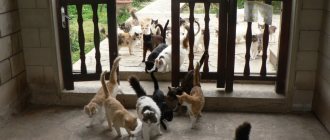Risk for kittens too
Dogs can pose a risk to cat babies. Mother cats are forced to leave their habitats while hunting. A hungry dog doesn't care much about who or what becomes its prey. Because of this, cats would do everything possible to not only hide their kittens as securely as possible, but also to instill as much fear in the neighborhood dogs as possible.
Lack of fear in cats towards dogs
Cats are practically not afraid of dogs. This is one of the reasons why cats are more likely than dogs to initiate fights. Instead of running away from an approaching dog as quickly as possible, the cat remains alert and thinks about the current situation.
Cats tend to tease canine representatives. They often slowly walk past dogs, wagging their tail, provoking them into conflict. In a critical situation, the cat quickly climbs a tree or hill without any sense of fear or danger.
Foraging
Competition for food and edible waste was most often one-sided. Dogs occupied a more advantageous position when they were close to people. Cats had to rely on their natural agility to avoid various troubles.
Guardian correspondent John Bradshaw once studied the behavior of wild cats in a Turkish village. One year, cats were everywhere and obtained food by begging for it from local residents and tourists. The following year, packs of dogs were already roaming the streets, and the journalist got the impression that the cats had disappeared. He thought so until he looked at the village from above and saw that the cats had simply moved onto the flat roofs. Most likely, they went down in search of food at night when the dogs were sleeping.
Method one - introduction
You can stop your dog from running after cats if you introduce them to them at home. On the street, this method will not be effective.
First you need to choose an animal that can reconcile with your pet. If it is necessary to place a cat in a house where a dog has always lived, a conflict situation will arise. The dog will chase a representative of the cat tribe, protecting its territory from the encroachments of an uninvited guest. If the owner was previously a “mustachioed-striped” one, he will defend himself by attacking his opponent.
For the first acquaintance, it is better to choose an animal that previously lived in a family or shelter with other animals. In this case, it will be easier to make friends between two pets.
Efforts must be made to make the dating process peaceful. This will be stressful for your pets, so create a comfortable environment for them for the first meeting, prepare treats, and think about other reward methods. Some tips:
- Prepare the tidbits in advance. For a dog you can prepare pieces of meat products, but for a cat it is better to take chicken or tuna fillet;
- If your dog is used to your commands, refresh his memory. If not, you will have to train her to do the following:
- sit;
- approach the owner;
- stop doing something when ordered.
This training will help stop your pet during an attack or chase of a cat.
- Before meeting him, it is best to take your pet for a walk so that he has as little energy as possible to chase the mustachioed stranger.
Acquaintance should take place under the vigilant control of the owner. The dog must be held by the collar or use a short leash. If he clearly obeys the command and leaves the cat alone upon request, reward him with a “yummy” to encourage such exemplary behavior.
Consider having someone other than you present during the animal encounter. Having an assistant will greatly facilitate the dating process - it will not be difficult to keep track of both pets.
It is important to allow the cat and dog to sniff each other. There is no need to keep them at different ends of the room. When acting as a mediator, be alert and respond quickly to signs of aggression from one side or the other.
Encouragement as a way to stop a dog from chasing cats
If the animals behave well, be sure to praise them, pet them, and feed them prepared treats. The most difficult will be the first weeks, during which it is necessary to stop the animals from attacking each other. Be sure to praise them for exemplary behavior.
Method two is to train the dog to stop unwanted actions.
If you intend to teach your dog to respond to cats, you will have to teach him to clearly respond to commands.
- Hold a piece of meat in each palm. Bring one hand to your pet's nose and let him smell. Your pet will understand well that there is a “yummy” sandwiched in the palm of your hand. The hand should be kept clamped, not allowing him to get to the treat;
- When trying to get the contents of your fist, pull the dog back and say “ugh”. She must clearly understand that you do not like her behavior. It is important to ignore her behavior and ensure that she stops all attempts to get to the tasty morsel;
- When the pet obeys the “fu” command, praise it and give it a treat from the other hand. Giving treats from a clenched fist that the dog wanted to unclench is not allowed.
- The exercise must be constantly repeated in order to bring the execution of the owner’s commands to automaticity. The dog must, on command, stop trying to get a treat from a clenched fist and sit in front of the owner.
Once the command has been sufficiently practiced, start using it in the presence of the cat. As soon as the animals are nearby, say “fu”. The dog will remember the command and associate it with a treat clenched in his fist. It is important to ensure that he leaves the cat alone at the command “fu” and does not perceive the “tabby” as prey.
How to make friends between a cat and a dog?
- When meeting for the first time, it is very important to be patient. If possible, you should keep your pets in different places in the apartment so that they gradually get used to each other’s smell.
- It is worth working on the dog’s behavior in advance: praising it for appropriate behavior, treating it with a treat.
- After some time, it’s time to arrange a “confrontation.” A large room is suitable for this; each pet should have its own personal space. You cannot push them towards each other, force them to make contact. Let the acquaintance be as natural as possible.
- After the first meeting, it will be necessary to promote communication and rapprochement between the animals. This can be done through walking and eating together. For cats, a walk is always an unusual stressful situation. During walks, the dog will be a familiar partner in an unfamiliar environment, and the cat will perceive the dog as a protector.
- Feeding animals together will bring them together. To begin with, you should place the bowls at the maximum distance from each other so that the animals do not start competing for food. Then the bowls need to be gradually brought closer together so that the pets eventually eat together.
- Playing games together will help you make friends. If during the game one animal bites another, the game must be stopped immediately, firmly saying “no”. There is no need to shout and scold the offender: this will only intensify the hostility.
- Friendship is always a matter of habit and personal preference. Cats and dogs speak different languages, so making friends with them is not always possible. You need to be patient and not harm your pets in an attempt to bring them together. Perhaps over time, pets will get used to each other, and their relationship will improve.
Boredom and desire to play
Once again, different language comes into play. If the puppy wants to show his affection, to play, he wags his tail, which the cat again sees as aggression.
The dog is ready for communication and pampering, she wants to play catch. But the cat doesn’t like this type of communication. She is not happy when boundaries are violated and personal contact is made. And if there were any other animal in the place of the dog, the purr would act the same way.
Let's imagine that a puppy came to meet a cat and it lowered its ears, arched its back, wagging its tail a little - all signs to attack the noisy and pestering creature. How does the dog understand this? Indeed, in his language it is precisely this behavior that is associated with the latter’s subordination. The puppy naively believes that the cat is afraid and a “joyful meeting” occurs after which the dog will remember for the rest of his life that it is better not to meet with cats and there is no need to expect anything good from it.
Division of territory
Both types of pets mark their territory and defend it throughout their lives.
It is generally accepted that cats always run away from attacking dogs. But that's not true. If a furry individual is in its territory, then it will not run away, at least not immediately. If a dog appears, even if it is passing by, the cat will rear up, hiss and begin to slowly advance in order to scare away the unexpected guest. And the dog, feeling that it is stepping into forbidden territory, will most likely run away. This law applies to domestic animals that live on private plots.
Historical reasons
A dispute between two dogs is often resolved without actual fighting because dogs have inherited a complex set of signals from the wolf, their ancestor. These signals stop the animal when it sees a more dangerous opponent. Cats, unlike dogs, originate from solitary predators. They lack such abilities because they do not have such a frequent need for contact. It follows that cats are more cautious, especially in deciding whether to get into a fight or not.
Dogs were domesticated by early hunter-gatherers approximately 15,000 years ago, if not earlier. One can only speculate whether they were then “man’s best friends” or not. By the time cats appeared, dogs had already played a significant role in human life: they hunted next to him, guarded houses, herded and drove livestock, and even kept him warm on cold nights.
Cats first showed an interest in human homes about 10,000 years ago . Although this can be called a kind of opportunism. In those days, the human habit of storing food led to the emergence of house mice as a serious pest. Only since the time of the ancient Egyptians has the first evidence of cohabitation between cats and humans been visible. Dogs have had the advantage for thousands of years of being well cared for by their owners, while very few cats have been able to do the same.
Humanity has farted 17 quadrillion times throughout history.
The average person farts 14 times a day. The Deadspin publication was not too lazy to count how many times the entire population of the planet farted in this case. We know approximately how long we have inhabited the Earth, we know how many years we live on average, and we know how many of us there are. This allows us to make a rough calculation. That comes out to an astonishing figure of 17 quadrillion farts.
ILLUSTRATION: PIRO4D / PIXABAY / FAKTRUM
Unaccustomed to each other
Some people believe that the enmity between cats and dogs is fictitious and is an ordinary fairy tale that we are accustomed to since childhood. Indeed, it is enough to carefully look at the behavior of cats and dogs living together in the same territory. For example, a kitten and a puppy growing up together will not have conflicts in the future. You can often see that even yard cats and dogs get along well together and have no conflicts with each other, but strangers, cats or dogs, who covet their food or territory immediately become an object from which this food and territory should be protected.
Method five - make the cat unattractive to the pet
Try to create unpleasant associations in your dog with chasing a cat. Use any methods that are harmless to the animal׃
- sharp sound;
- cold water;
- dissatisfied tone;
- citrus-scented spray, etc.
Try spraying water on your pet if he chases the cat. The dog will remember the connection between chasing the “striped” and cold water. You can show with your voice that you are annoyed by your pet's bad behavior. Every time, let him know that his actions cause your dissatisfaction.
The pet must realize that when it actively reacts to the appearance of a cat on the horizon, the owner will be angry. You cannot shout at the dog, hit it or sharply pull the leash. You need to reprimand the dog in a calm tone with dissatisfied intonations. Animals perceive their owner’s moods very well.
If you cannot cope with the problem, contact a dog handler. He will help with training and give recommendations for further training of the dog.
Old grudge
Like people, many animals remember old grievances all their lives.
Same with dogs. If she had an experience of meeting a cat that ended badly for the dog, then, most likely, when meeting another cat again, he will remember the previous fight and try to achieve retribution. We also recommend reading:
The largest dog breeds What is domestication in animal husbandry Why you should get a cat: reasons voiced by scientists Euthanasia of animals
The cause could be a scratch caused by a cat's paw or a blow to the nose.
Method three - using a clicker
It is sometimes possible to wean a dog from approaching a cat using a clicker. You can buy it specifically for raising your pet. The device produces a clicking sound when you press a special button. The dog begins to respond to the click and associate it with the “correct” behavior. You can buy this device online or at any pet store. How to train?
- The pet must get used to the clicker. The click should be made immediately when the pet performs the command correctly. A calm attitude towards the cat should also be accompanied by a clicker signal;
- After the click, be sure to give your pet a piece of treat. The dog must understand and remember the connection between exemplary behavior and the click, and then between the clicker signal and the reward;
- During training, imitate the movements of a cat. This complicates training, but allows the pet to get used to living together with other animals;
- Place your dog in front of you, say “sit” and begin to quickly back away. Stop. If your dog stays put, click the clicker, praise him, and give him food.
It will not be possible to train your pet not to react to a new “neighbor” in one day. However, he will gradually remember what behavior deserves praise. Use the “fu” command if your pet starts chasing the cat. Praise your dog constantly if he follows commands accurately. While running after the striped one, stop her with the command “fu”. If she stops chasing, click the clicker and then treat her with a treat.
Cats are not social
The second version is that cats are the ones who don’t like dogs. While dogs often gather in packs, cats, on the contrary, prefer to lead a solitary lifestyle. This is due to the fact that representatives of the cat family, for the most part, do not like to contact other individuals. If a cat is hostile towards its relatives, what can we say about relationships with representatives of another species. Often, a dog attacking a cat is simple curiosity or a response to a provocation.
It's about enzymes
The fourth version is associated with the different structure of organisms. There is a theory that representatives of the cat family produce a certain special enzyme that negatively affects the subconscious of dogs, making them aggressive and agitated. This theory could explain everything, but it falls apart due to the fact that many cats and dogs are friends and even spend most of their time together without experiencing discomfort.
Hunting instinct
The zeal of dogs for cats can also be explained by the hunting instincts inherent in many breeds. For such dogs, many animals are regarded as potential prey, regardless of whether the cat is a raccoon or a fox, therefore, in dogs, the hunting instinct is triggered, and in cats, the instinct of self-preservation begins and the chase and hostility begin.
© shutterstock
Assess your dog's interest level
It is important to understand the reasons that prompt your pet to run after cats. Usually they rush off to play with the cat or their innate instinct is triggered.
In this case, it is necessary to intervene to prevent the animals from harming each other. Cats can be very aggressive when protecting their offspring.
When a dog chases a cat as if it were prey, the situation is very serious. The dog may kill him or suffer himself. During the chase, she does not notice what is happening around her. Your pet may get run over by a car or be chased by stray dogs, who will begin to act aggressively against your pet.
Observation
When taking your dog outside, constantly monitor its behavior, and always observe how it reacts to your commands. If a cat appears in your home, do not leave the animals unattended for a month. Encourage both for good behavior, and also strictly reprimand for conflicts that arise.
Nutrition
The dog should not be allowed to eat from the cat's dishes. This causes stress for the cat. He will “take revenge” on the offender, and also show aggression towards him. A very good situation is when the animals’ bowls are nearby, and they calmly react to each other’s proximity while eating.
However, this is not easy to achieve, as the dog will try to eat the cat's treat. Patience, as well as long-term training, will teach your pet not to look into “someone else’s” plate. Exercise your dog should be done regularly. It is important to let her understand how to behave in the presence of a cat. Repeat the exercises many times, encourage your pet and it will lead to results.
Currently reading:
- Review of the best dog breeds for apartments
- Games to choose for training a dog
- The American Cocker Spaniel is an adroit hunter and loyal friend.
- Recommendations for obedience of a dog if it growls
Accumulated aggression
Stress breeds aggression (over-arousal) within the animal. So if a dog has experienced severe emotional stress or physical torture, it will take out an avalanche of feelings on a weaker creature. In such a situation, not only the cat, but also the person can get it.
Method four - weaning off reacting to neighbor's cats
It is also possible to train a dog to stop attacking cats on the street. At first, your pet will have to be taken out for walks only on a leash. Allow him to walk freely only in places where the appearance of “striped predators” will be excluded.
- Take your pet out into the yard on a leash. If he tries to chase the cat, use the "ew" command. When your pet is on a leash, it is easier to stop him. However, it is necessary to ensure that you do not have to restrain the tearing dog, but that he stops on his own after your command.
- To prevent your dog from feeling threatened by cats, try to attract its attention to you. Behave calmly, reward your dog for paying attention only to you, without being distracted by the presence of other animals.
- Train your dog to always follow you, even when you let him off the leash. Practice the “near” command using a clicker or treat. Praise your pet for good behavior and for strictly following commands.
- If you live not in an apartment building, but in the private sector, try to enclose your yard with a fence. This will significantly reduce the risk of unwanted “tailed” guests appearing on your territory.
Teach your dog not to react to the appearance of street cats. Whenever your pet tries to show aggression, use the “fu” or “sit” command. Be sure to reward good behavior with a treat or kind words.











